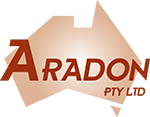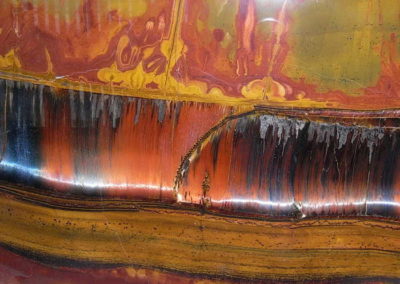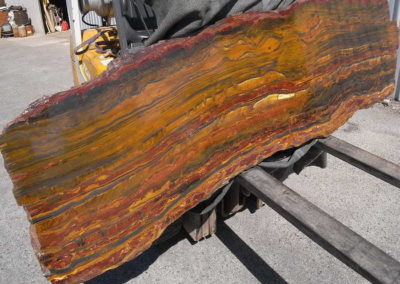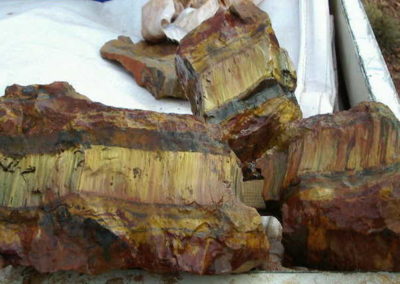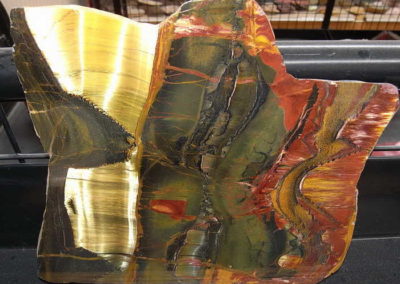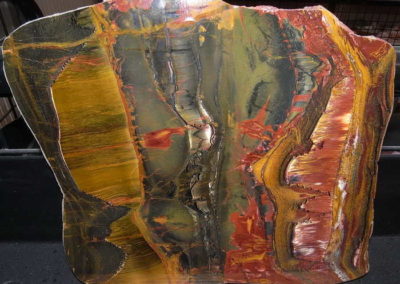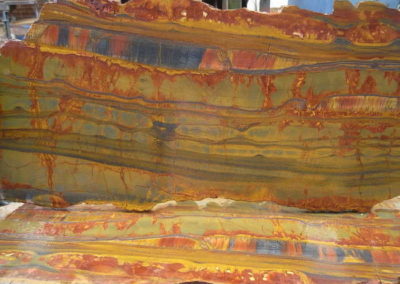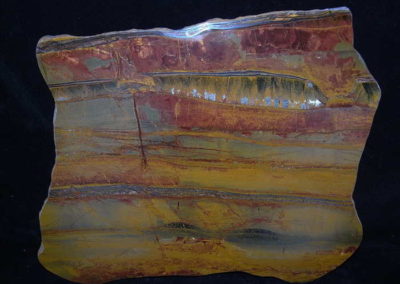(Copyright by Jenny Bevan- Senior Curator – E. de C. Clarke Earth Science Museum – University of Western Australia)
This stone has had a complex history. These are some of the events which have produced the structures and minerals which give it such an interesting and colourful appearance.
First: Sediments were laid down at the bottom of a shallow sea.
Although the layers have now been bent, jumbled up and replaced by other minerals, they were once parallel layers of fine mud on the bottom of the sea, over two and a half billion years ago. The layers alternated between iron-rich and silica-rich, reflecting changing conditions in the zone from which they were deposited. The black fine layers are very rich in iron oxides whereas the lighter coloured layers are rich in silica. They are called “banded iron-formation” or “BIF”. Where did the iron and the oxygen come from? The oxygen in our atmosphere is produced by photosynthesis. The early Earth’s atmosphere had little to no oxygen. When oxygen-producing photosynthetic bacteria first evolved more than 2,700 million years ago, they gave off oxygen as a waste product, which built up in the atmosphere and dissolved in seawater. When iron produced largely by huge submarine volcanoes came into contact with this oxygen, it was precipitated as iron oxide (hematite, “rust”) in sea floor mud.
Then: A selection of processes, some of which may have happened simultaneously, such as
Heating and burial bringing about the crystallization of layers of the blue fibrous mineral riebeckite and other minerals.
The riebeckite formation probably involved not very high temperatures (up to 150 degrees Celsius) and moderate depth of burial, as part of the process of turning the loose sediment into rock. Some deformation may have contributed to the formation of the mineral as layers of fibres at right angles to the layering, rather than as random crystals. It is also likely that solutions carrying sodium penetrated along some layers rather than others, which is where the riebeckite formed. Growth of the crystals has appeared to have distorted some existing thin sedimentary layers. Some other minerals, such as magnetite, also formed during heating and burial.
Earth movements causing crumpling of the rocks when some of the layers were distorted and broken.
This could have happened in soft sediment during the crystallization of the fibrous mineral as well as later when the rocks were solid. As well as compression to form folds, there was also an extension period, when some of the thicker layers were broken into chunks and pulled out sideways. Minerals crystallized in the low-pressure zones between the chunks, and layers curved in and around them.
Redistribution of iron oxides and silica by dissolving and redeposition.
Watery fluids passing through heated rock can dissolve material and redeposit it elsewhere. Sometimes structures have been obliterated, in other places we can see traces of what was originally there. The fibrous layers of riebeckite crystals have in some places been replaced by silica with fine dust of yellow goethite outlining the shapes of the original crystals, in the same way that fossil wood preserves the outlines of the cells and growth rings. Occasionally there is a red hematite crystal outline.
In other places, red and yellow iron oxides and/or silica have been deposited as veins or replaced the wall areas of fine cracks in the rock. There have probably been several phases of this mobilization, some quite early on and some much later. About 2,000 million years ago the Pilbara and many of the other very old pieces of continental crust were joined together in a supercontinent. When this supercontinent started to break up, waters heated up by volcanic activity dissolved much silica from BIF leaving huge iron ore deposits of almost pure hematite (more than 65% iron).
So, what minerals make the colours?
WHITE – Quartz: SiO2
The pure mineral is colourless or white. However, if it encloses a microscopic dust of coloured minerals, it will take on that colour, so jasper, for example, is quartz coloured by red hematite (iron oxide).
YELLOW – Goethite: FeO(OH) – may also contain other hydrated iron oxides, “limonite”.
The powdered mineral is yellow. Goethite can also be shades of brown when in larger crystals.
RED – Hematite: Fe2O3
The powdered mineral is blood red. The mineral can also have a dark grey, metallic appearance when in larger crystals.
BLUE – Riebeckite Na2Fe5[Si8O22](OH) 2
This is a dark blue fibrous amphibole mineral, sometimes called “crocidolite”.
GREEN – usually a mixture of blue riebeckite and yellow goethite, often hosted by quartz
BLACK – Hematite Fe2O3, and/or Magnetite Fe3O4
